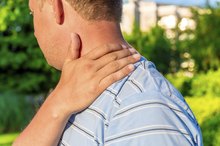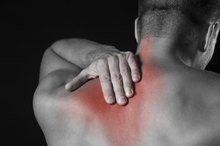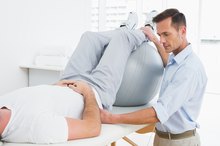What Are the Treatments for a Bone Spur in the Shoulder?
Bone spurs do not always require treatment, and you may not even know you have them. Sometimes, however, they can injure the rotator cuff tendons that move your shoulder -- causing pain, swelling, inflammation or tears in the tendons. Spurs may develop with arthritis and aging, trauma or repeated overuse of your arm. Treatments for conditions caused by bone spurs include conservative measures, nonsurgical interventions or surgery. Seek medical attention if you lose the ability to move the shoulder or if your pain does not improve within a few days.
If you are experiencing serious medical symptoms, seek emergency treatment immediately.
Conservative Management
Mild shoulder pain caused by bone spurs may be successfully treated at home. If your shoulder pain is due to a recent trauma, cold may be effective for the first 24 to 48 hours after injury. Heat can also be used to increase blood flow to your shoulder and promote healing. This is often effective for bone spurs that have been caused by ongoing conditions such as arthritis. If approved by your doctor, nonsteroidal antiinflammatory medications such as ibuprofen (Advil, Motrin) or naproxen (Aleve) may help provide relief.
- Mild shoulder pain caused by bone spurs may be successfully treated at home.
- This is often effective for bone spurs that have been caused by ongoing conditions such as arthritis.
Activity Modification
Recovery & Rehabilitation Time for Shoulder Surgery to Remove Bone Spur
Learn More
Daily activities can increase pain caused by bone spurs, particularly if they require you to reach overhead. If these activities cannot be avoided, you may need to temporarily change the way you do them. For example, by dangling your arm and bending at your waist, you can apply deodorant to your underarm without lifting your arm overhead. Sleeping can also be difficult with a painful shoulder 1. Lying on the unaffected side with a pillow under the affected arm may decrease pain while you sleep.
- Daily activities can increase pain caused by bone spurs, particularly if they require you to reach overhead.
Nonsurgical Treatments
If conservative treatment fails, your doctor may prescribe oral steroids or inject medication directly into your shoulder joint. You may likewise benefit from physical therapy involving not only pain-relieving interventions such as ultrasound, low-level laser therapy and electrical stimulation, but also exercises to improve shoulder motion and strength. A procedure called prolotherapy -- injection of a substance into the joint to stimulate a repair response -- has been proposed as a complementary therapy for shoulder pain, but there is not yet sufficient scientific evidence to recommend its use for the shoulder.
- If conservative treatment fails, your doctor may prescribe oral steroids or inject medication directly into your shoulder joint.
- A procedure called prolotherapy -- injection of a substance into the joint to stimulate a repair response -- has been proposed as a complementary therapy for shoulder pain, but there is not yet sufficient scientific evidence to recommend its use for the shoulder.
Surgery
How Long Is Rehab After a Bicep Surgery?
Learn More
Bone spurs that limit your range of motion or press on nerves may require surgical removal. Tears in the rotator cuff tendons are sometimes repaired when these spurs are removed. Depending on the severity of the damage, surgery may be performed arthroscopically -- using 3 very small incisions -- or it may require a larger incision. In younger people, arthroscopic surgery is typically performed. Physical therapy is prescribed to improve range of motion and strength after surgery 4.
- Bone spurs that limit your range of motion or press on nerves may require surgical removal.
- Tears in the rotator cuff tendons are sometimes repaired when these spurs are removed.
Related Articles
References
- The Open Orthopaedics Journal: The Painful Shoulder -- Shoulder Impingement Syndrome
- South County Orthopedics: Nonsurgical Shoulder Impingement Rehabilitation Protocol
- The Open Orthopaedics Journal: Arthroscopic Management of Shoulder Osteoarthritis
- University of Rochester Medical Center: When to Use Hot and Cold Therapy
- American Academy of Orthopaedic Surgeons: Shoulder Pain and Common Shoulder Problems
- American Family Physician: Management of Chronic Tendon Injuries
- American Academy of Orthopedic Surgeons. (2018). Arthritis of the Shoulder. https://orthoinfo.aaos.org/en/diseases--conditions/arthritis-of-the-shoulder
- Kadi R, Milants A, Shahabpour M. Shoulder Anatomy and Normal Variants. J Belg Soc Radiol. 2017;101(Suppl 2):3. doi:10.5334/jbr-btr.1467
- Murphy RJ, Carr AJ. Shoulder pain. BMJ Clin Evid. 2010;2010:1107.
- Singh B, Bakti N, Gulihar A. Current Concepts in the Diagnosis and Treatment of Shoulder Impingement. Indian J Orthop. 2017;51(5):516-523. doi:10.4103/ortho.IJOrtho_187_17
- Minns lowe CJ, Moser J, Barker K. Living with a symptomatic rotator cuff tear 'bad days, bad nights': a qualitative study. BMC Musculoskelet Disord. 2014;15:228. doi:10.1186/1471-2474-15-228
- Cleveland Clinic. Frozen Shoulder. 2019.
- De carli A, Pulcinelli F, Rose GD, Pitino D, Ferretti A. Calcific tendinitis of the shoulder. Joints. 2014;2(3):130-6.
- Raney EB, Thankam FG, Dilisio MF, Agrawal DK. Pain and the pathogenesis of biceps tendinopathy. Am J Transl Res. 2017;9(6):2668-2683.
- Alentorn-geli E, Assenmacher AT, Sánchez-sotelo J. Distal biceps tendon injuries: A clinically relevant current concepts review. EFORT Open Rev. 2016;1(9):316-324. doi:10.1302/2058-5241.1.000053
- Wilk KE, Macrina LC, Cain EL, Dugas JR, Andrews JR. The recognition and treatment of superior labral (slap) lesions in the overhead athlete. Int J Sports Phys Ther. 2013;8(5):579-600.
- Chillemi C, Franceschini V. Shoulder osteoarthritis. Arthritis. 2013;2013:370231. doi:10.1155/2013/370231
- Warth RJ, Martetschläger F, Gaskill TR, Millett PJ. Acromioclavicular joint separations. Curr Rev Musculoskelet Med. 2013;6(1):71-8. doi:10.1007/s12178-012-9144-9
- Defroda SF, Nacca C, Waryasz GR, Owens BD. Diagnosis and Management of Distal Clavicle Osteolysis. Orthopedics. 2017;40(2):119-124. doi:10.3928/01477447-20161128-03
- Dumont GD, Russell RD, Robertson WJ. Anterior shoulder instability: a review of pathoanatomy, diagnosis and treatment. Curr Rev Musculoskelet Med. 2011;4(4):200-7. doi:10.1007/s12178-011-9092-9
- Chalidis B, Sachinis N, Dimitriou C, Papadopoulos P, Samoladas E, Pournaras J. Has the management of shoulder dislocation changed over time? Int Orthop. 2007;31(3):385-9. doi:10.1007/s00264-006-0183-y
- Armstrong A. Diagnosis and clinical assessment of a stiff shoulder. Shoulder Elbow. 2015;7(2):128-34. doi:10.1177/1758573215569340
- Dee SW, Kao MJ, Hong CZ, Chou LW, Lew HL. Chronic shoulder pain referred from thymic carcinoma: a case report and review of literature. Neuropsychiatr Dis Treat. 2012;8:399-403. doi:10.2147/NDT.S36476
- Park SI, Choi YK, Lee JH, Kim YM. Effects of shoulder stabilization exercise on pain and functional recovery of shoulder impingement syndrome patients. J Phys Ther Sci. 2013;25(11):1359-62. doi:10.1589/jpts.25.1359
- Block JE. Cold and compression in the management of musculoskeletal injuries and orthopedic operative procedures: a narrative review. Open Access J Sports Med. 2010;1:105-13.
- Shih YF, Liao PW, Lee CS. The immediate effect of muscle release intervention on muscle activity and shoulder kinematics in patients with frozen shoulder: a cross-sectional, exploratory study. BMC Musculoskelet Disord. 2017;18(1):499. doi:10.1186/s12891-017-1867-8
- Razmjou H, Robarts S, Kennedy D, Mcknight C, Macleod AM, Holtby R. Evaluation of an advanced-practice physical therapist in a specialty shoulder clinic: diagnostic agreement and effect on wait times. Physiother Can. 2013;65(1):46-55. doi:10.3138/ptc.2011-56
- Sun Y, Chen J, Li H, Jiang J, Chen S. Steroid Injection and Nonsteroidal Anti-inflammatory Agents for Shoulder Pain: A PRISMA Systematic Review and Meta-Analysis of Randomized Controlled Trials. Medicine (Baltimore). 2015;94(50):e2216. doi:10.1097/MD.0000000000002216
- Moore N, Pollack C, Butkerait P. Adverse drug reactions and drug-drug interactions with over-the-counter NSAIDs. Ther Clin Risk Manag. 2015;11:1061-75. doi:10.2147/TCRM.S79135
- Vyvey M. Steroids as pain relief adjuvants. Can Fam Physician. 2010;56(12):1295-7, e415.
- American Academy of Orthopedic Surgeons. (2018). Arthritis of the Shoulder.
- Fields KB. (2018). Evaluation of the adult with shoulder complaints. In: UpToDate, O'Connor, FG (Ed), UpToDate, Waltham, MA, 2014.
- Tonino PM, Gerber C, Itoi E, Porcellini G, Sonnabend D, Walch G. Complex shoulder disorders: evaluation and treatment. J Am Acad Orthop Surg. 2009 Mar;17(3):125-36.
Writer Bio
Aubrey Bailey has been writing health-related articles since 2009. Her articles have appeared in ADVANCE for Physical Therapy & Rehab Medicine. She holds a Bachelor of Science in physical therapy and Bachelor of Arts in psychology from the University at Buffalo, as well as a post-professional Doctor of Physical Therapy from Utica College. Dr. Bailey is also a certified hand therapist.








